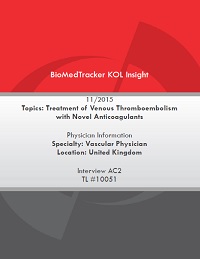Report Library
All Reports
Treatment of VTE - EU KOL Interview
November 04, 2015
This interview with an EU vascular physician explores the dynamics in the 5 major European markets regarding the introduction of
novel/direct oral anticoagulants
(NOAC, DOAC) in the treatment of venous thromboembolism (VTE) and prevention of recurrence. The KOL has been involved in research
on usage of NOACs in
Europe and has a network of contacts in the various countries. Topics include both physician views and reimbursement.
Highlights
Discusses Major Country-specific Factors Impacting Usage of Particular NOACs, Including:
BioMedTracker will be offering KOL Reports and Physician Pulse Surveys for purchase a la carte, or access to all reports and surveys can be purchased as a subscription to KOL Insight. For more information on KOL Insight subscription, please email BioMedTracker or call BioMedTracker Client Services at (858) 200-2357.
For our disclosures, please read the BioMedTracker Research Standards.
Highlights
Discusses Major Country-specific Factors Impacting Usage of Particular NOACs, Including:
- Quick adopters versus conservatism, and physician preferences in different countries.
- Impact of physician remuneration for monitoring warfarin and local influences on reimbursement.
- Potential countrywide changes in reimbursement.
- Influence of various pharmas in different countries.
- Degree of outpatient versus inpatient treatment.
- Timing of market entry.
- Advantage of Xarelto and Eliquis not needing lead-in heparin, which is important in countries where treatment is primarily outpatient.
- Eliquis has best bleeding profile, two doses for long-term use, and data against aspirin.
- While twice-daily compared to once-daily Xarelto, most patients are elderly and do not mind twice-daily dosing, since they are already taking other such drugs. Once-daily dosing more of an advantage in younger active patients.
- Xarelto will have data on a second dose and against aspirin from EINSTEIN CHOICE.
- Expects both doses to be more effective than aspirin.
- There could be a small increase in major bleeding with the current 20 mg dose, but potentially no increase versus aspirin for the 10 mg dose, though it is likely to have greater non-major bleeding.
- Pradaxa advantageous in patients at high risk for an ischemic stroke, but a number of factors leading to its decline in use.
- Gives expectations for usage in the different markets, based on country-specific factors and drug profiles.
- The Pradaxa antidote (idarucizumab, Praxbind) will lead to a limited increase in use of the drug, but will not resurrect it.
- The factor Xa inhibitor antidote (andexanet) will also only have a small impact on its own, giving doubters some more confidence, but not overcoming other arguments against use, such as cost and physician remuneration.
- Nevertheless, expects these factors will be overcome over the next 4-5 years and lead to the vast majority of VTE patients taking
NOACs.
- Physician education will be important.
- Cost-effectiveness arguments in favor of the NOACs.
BioMedTracker will be offering KOL Reports and Physician Pulse Surveys for purchase a la carte, or access to all reports and surveys can be purchased as a subscription to KOL Insight. For more information on KOL Insight subscription, please email BioMedTracker or call BioMedTracker Client Services at (858) 200-2357.
For our disclosures, please read the BioMedTracker Research Standards.
| Indications Covered: | Venous Thromboembolism (VTE) |
